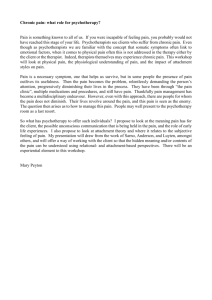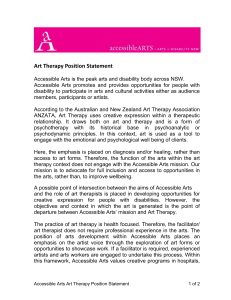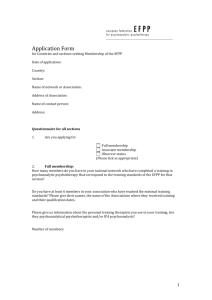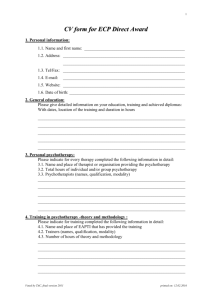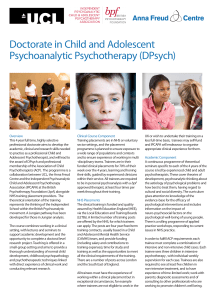Child and Adolescent Psychotherapy
advertisement
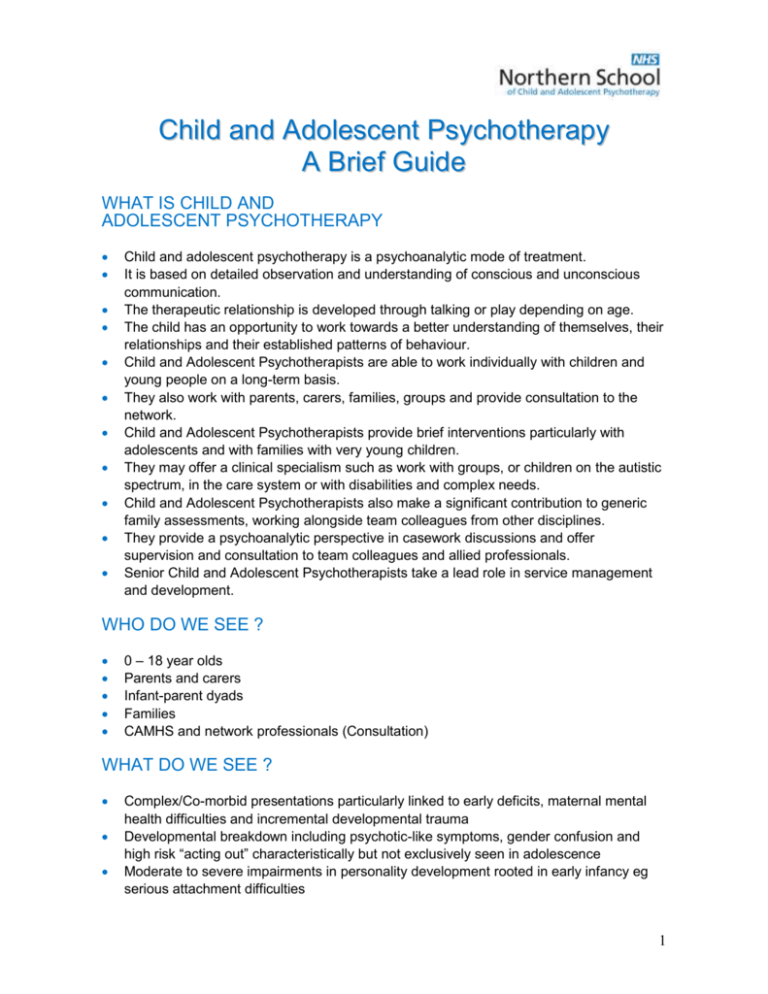
Child and Adolescent Psychotherapy A Brief Guide WHAT IS CHILD AND ADOLESCENT PSYCHOTHERAPY Child and adolescent psychotherapy is a psychoanalytic mode of treatment. It is based on detailed observation and understanding of conscious and unconscious communication. The therapeutic relationship is developed through talking or play depending on age. The child has an opportunity to work towards a better understanding of themselves, their relationships and their established patterns of behaviour. Child and Adolescent Psychotherapists are able to work individually with children and young people on a long-term basis. They also work with parents, carers, families, groups and provide consultation to the network. Child and Adolescent Psychotherapists provide brief interventions particularly with adolescents and with families with very young children. They may offer a clinical specialism such as work with groups, or children on the autistic spectrum, in the care system or with disabilities and complex needs. Child and Adolescent Psychotherapists also make a significant contribution to generic family assessments, working alongside team colleagues from other disciplines. They provide a psychoanalytic perspective in casework discussions and offer supervision and consultation to team colleagues and allied professionals. Senior Child and Adolescent Psychotherapists take a lead role in service management and development. WHO DO WE SEE ? 0 – 18 year olds Parents and carers Infant-parent dyads Families CAMHS and network professionals (Consultation) WHAT DO WE SEE ? Complex/Co-morbid presentations particularly linked to early deficits, maternal mental health difficulties and incremental developmental trauma Developmental breakdown including psychotic-like symptoms, gender confusion and high risk “acting out” characteristically but not exclusively seen in adolescence Moderate to severe impairments in personality development rooted in early infancy eg serious attachment difficulties 1 Mind – Body disturbances including somatisation, psychosomatic problems and the emotional/psychic impact of chronic medical conditions Depression – moderate and severe with suicidal ideation Severe, deep-seated anxiety states including ADHD/ASD type personality structures Eating disorders WHAT ARE OUR DISTINCTIVE SKILLS AND KNOWLEDGE BASE ? Close and detailed observation of infants, children, young people and parent-child interactions Extensive and in depth knowledge of unconscious processes both in personality formation and development and in organisational functioning Systematic use of transference and countertransference dynamics to effect change Psychoanalytic perspective on development and behaviour Capacity to contain, understand and manage high levels of anxiety and disturbance and the impact of this on individuals, teams and organisations Ability to deliver an evidence based treatment modality effective in changing/modifying pathological internal mental states with long term benefits ( “sleeper effect” outcome*) Cross –discipline research mindedness Breadth and depth of knowledge and experience of whole range of difficulties presenting to CAMHS * Sleeper effect – observation and evidence of continuing development and improvement extending beyond termination of therapy. WHAT DO WE OFFER ? State of Mind Assessments Contribution to multidisciplinary team assessments including infant/child observations Interpretation of the child’s experience and understanding of the world inside and outside of her/himself Range of therapeutic interventions Brief psychotherapy (young people, parent-infant psychotherapy) Long term weekly psychoanalytic psychotherapy (min 30 sessions) Long term intensive psychoanalytic psychotherapy (3 times per week for min 1 year) Parent work (individuals or couples) inc carers Family consultations Network/professional consultations Groupwork Interventions and Consultation at Tier 4 level of severity averting the need for in-patient treatment and/or facilitating community based treatment Support and consultation to the multidisciplinary team Risk assessment and Management A psychoanalytically informed clinical opinion (“second opinion”) Consultation and support to Tier 1 and 2 practitioners Contribution to forensic assessments 2 WHERE CAN WE CONTRIBUTE TO SERVICE IMPROVEMENT AND DEVELOPMENT ? Distinctive, highly specialist contribution to CAMHS skill mix Service response to Looked After Children Early Intervention especially pre-school and adolescence Tier 4 to 3 Pathway Intensive community based treatment Schools and learning environments including services for Children with Special Needs Complex, high risk and forensic presentations Paediatric Liaison Perinatal/postnatal adversity IS CHILD AND ADOLESCENT PSYCHOTHERAPY EVIDENCE BASED? There is evidence to support the effectiveness of psychoanalytic psychotherapy for children/young people with a range of psychological disorders. Beneficial effects are shown with treatment on a variety of outcome measures and many studies showed that improvements were sustained or even enhanced at long-term follow-up. The majority of studies were undertaken in clinically referred samples rather than samples recruited for research. The majority of studies involved children with a range of diagnoses and co-morbid problems. The findings are likely to have relevance to the ‘real world’ setting. Child and adolescent psychotherapy is recommended in the NICE guidance for depression in children and young people. Kennedy, E (2004). Child and Adolescent Psychotherapy: A Systematic Review of Psychoanalytic Approaches. London: North Central London SHA. Kennedy E & Midgley N (Eds) (2007). Process & Outcome Research in Child, Adolescent and Parent-Infant Psychotherapy: A Thematic Review. London: NHS London. Lynda Ellis Clinical Director, NSCAP April 2008 3

